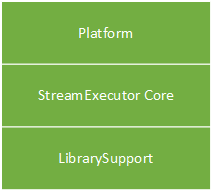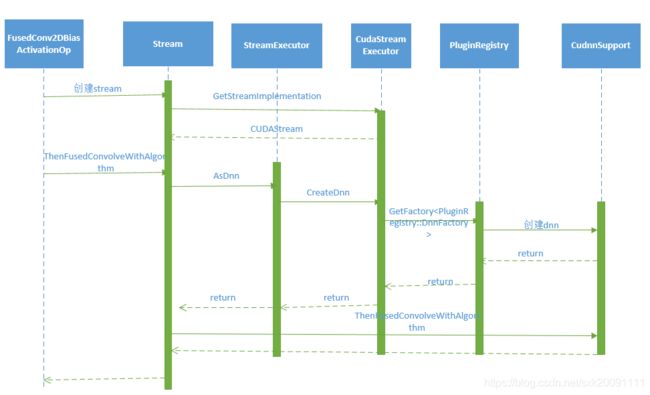tensorflow StreamExecutor
StreamExecutor框架
Plaftorm
Platform是StreamExecutor一个抽象的设备平台层,它是一个抽象类,具体实现的子类有CUDA , HOST, OpenCL。
通过GetExecutor() 就可以获取到相应的StreamExecutor指针。而对于platform的管理是借用MultiPlatformManager来进行管理的。
MultiPlatformManager的类主要函数如下:
主要通过RegisterPlatform中,其实这个类的内部会维护两张表,一张是(name, platorm),另外一张是(id, platorm)。 外部就可以
通过PlatformWithName 和 PlatformWithId 这两个函数来获取到相应的platform。而RegisterPlatform是在每个Platform模块在初始化的时候就注册。 以HostPlatform为例:
static void InitializeHostPlatform() {
std::unique_ptr
SE_CHECK_OK(MultiPlatformManager::RegisterPlatform(std::move(platform)));
}
REGISTER_MODULE_INITIALIZER(host_platform,
stream_executor::host::InitializeHostPlatform());
这种插件式的管理方式可以使得模块间很好的解耦, 当需要加入其它的模块的时候只需要创建一个Platform的子类模块,然后采用上面的方式注册进系统中就可以。
StreamExecutor 核心
StreamExecutorInterface具体的事例模块是采用注册回调函数的方式进行管理的,注册方式如下:
而MakeCUDAExecutorImplementaion的定义如下:
using StreamExecutorFactory =
std::function
那么在StreamExecutor 就可以通过platform_kind来进行获取对应的实例化的StreamExecutorInterface
通过这种方式可以很好的扩充新的设备相应的StreamExecutorInterface。
StreamExecutor 主要是获取Dnn, Blas, Fft, Rng(随机数)的操作对象, 而获取这些是通过一个StreamExecutorInterface类型的
implementation_来创建这些对象。而对于其它一些操作也可以通过自定义kernel,然后通过lauch去执行。StreamExecutorInterface
也是一个父类,具体使用是通过其子类来完成,这样根据不同的设备,不同的库可以进行很好的扩展。StreamExecutorInterface
会针对具体的设备进行事件,内存的管理(如cudaExecutor将帮我们完成复杂的cuda的事件管理, 显存管理)。
对于Dnn, Blas, Fft, Rng 的管理是采用PluginRegistry来管理的,这个类采用了单例模式来存储所有的插件模块。
查看以上的代码就可以看出是通过Platform::Id PluginId 构成一个二维的表来保存插件。
模块的注册如下所示:
以上的代码是cuda:cudnn 模块的插件初始化。
最终就可以在StreamExecutorInterface中通过PluginRegistry来使用具体的插件
最终的UML流程图












